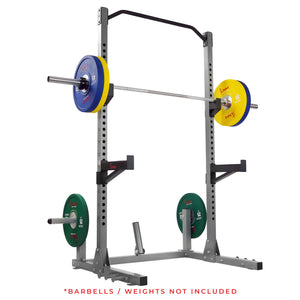Starting a new resistance training program can be an exciting and challenging experience. You might have started your regimen with some new bodyweight training equipment—which could make any fitness enthusiast drool. Or You could have also come across a vast library of muscle building programs that have you pumped for the next three months. But how do you know what equipment and exercises will help your body perform the best?
While we’ve learned about the basic of how the body builds muscles, specific training variables must be followed in order to see gains. One of the best ways to set yourself up for success in muscle building is to start by choosing multi-joint exercises over single-joint exercises.
Multi-Joint or Single-Joint Exercises?
An easy way to distinguish between a single-joint (SJ) and multi-joint (MJ) exercise is to consider the difference between a bicep curl and a bodyweight squat. When you perform a bicep curl you hold a weighted object (usually a dumbbell) in your hand around hip height and pull the weight up to your shoulder by bending your elbow. This only requires the movement of your elbow. In comparison, when you perform a bodyweight squat, your hips, knees, and ankles all flex and extend to perform the movement. This requires three joints instead of one.
Why Does This Matter When It Comes to Muscle Building?
While isolation exercises like the bicep curl are a staple in nearly every muscle building program, performing these types of single-joint exercises might not be the most effective way to develop a well-rounded muscular physique. In fact, researchers have found that adding single-joint exercises on top of a multi-joint plan won’t provide you with any additional benefit.
Another study looked at the physical changes between the two training styles on muscle performance and skinfold reduction (body fat reduction), and found that adding SJ exercise provided no additional benefit. MJ exercise has also been proven to be more effective at increasing overall strength than SJ exercises.
MJ exercises allow you to recruit larger amounts of muscle mass to carry out work. And since more muscles are involved when performing an exercise, the body releases greater amounts of testosterone and growth hormone when compared to SJ exercises. MJ exercises can, when done correctly, boost the maximum number of muscle fibers that your body can utilize.
While SJ exercises might not be the most beneficial when it comes to muscle growth, they can be helpful in targeting underdeveloped muscles and improving muscular symmetry. An added benefits of performing MJ exercises is that you get to train more muscles in a shorter amount of time. This can save you time while ensuring the development of a well-rounded muscular look.
If you are trying to build a well-rounded muscular physique without spending hours performing 3 sets of 10 repetitions for every muscle group on your body, try multi-joint exercises like squats, deadlifts, push-ups, pull-ups, and overhead presses. Below you can find a diagram comparing muscles involved for different MJ exercises and a few exercise demonstration videos.
SQUAT
Joints Involved:
Hip/Knee/Ankle
Targeted Muscles:
Glutes, Thighs, Core, Calves

DEADLIFT
Joints Involved:
Hip/Knee/Ankle/Shoulder
Targeted Muscles:
Glutes, Thighs, Back, Core, Calves

PULL-UP
Joints Involved:
Shoulder/Elbow
Targeted Muscles:
Back, Shoulders, Arms, Core

OVERHEAD PRESS
Joints Involved:
Shoulder/Elbow
Targeted Muscles:
Shoulders, Arms, Back, Core

PUSH-UP
Joints Involved:
Shoulder/Elbow
Targeted Muscles:
Chest, Arms, Shoulders, Core

Check out our YouTube channel for more exercise of the day videos!
























Add Your Name & Email
Please enter your name and email to continue.We won’t display your email publicly.